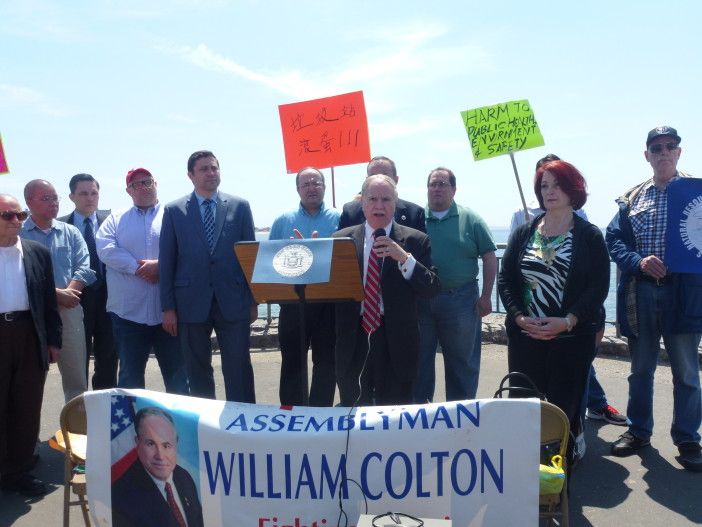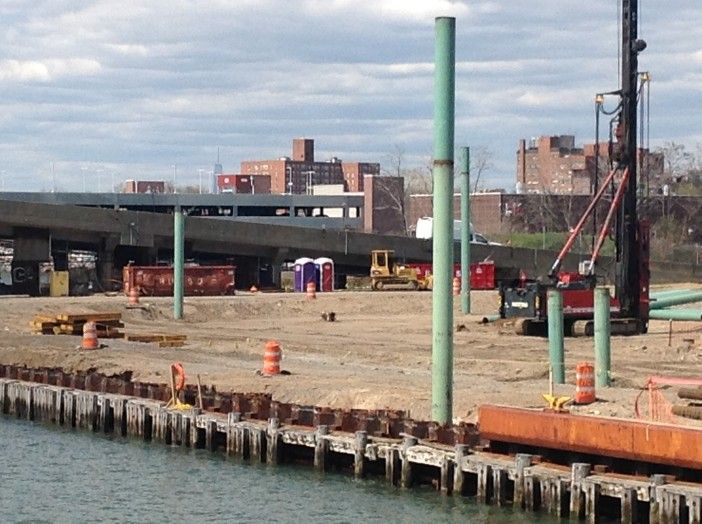Sloppy Construction At Contaminated Waste Station Site Puts Neighbors At Risk, Say Pols

Contractors working on the controversial Gravesend Bay Marine Waste Transfer Station are not taking the necessary precautions to protect residents from toxic chemicals found at the site, say local politicians.
At a press conference at Ceasar’s Bay promenade Sunday, Assemblyman William Colton and Councilman Mark Treyger shared evidence that construction workers violated the conditions of the construction permit for building the trash facility by leaving Gravesend Bay exposed to contaminated dust and debris.
Colton and Treyger have been on the front lines fighting the trash station plan — which they say will wreak environmental havoc on Southern Brooklyn — since it was proposed in 2005. Most recently, Colton created a neighborhood watch program, asking residents to document and photograph construction of the garbage station, sending tips by calling Colton’s office at 718-236-1598 or emailing neighborhoodwatch47@gmail.com.
Ida Sanoff, executive director of the Natural Resources Protective Association, examined the photos collected from the concerned neighbors and analyzed them to help Colton and Treyger understand the permit violations being committed. For example, one photo showed construction cranes doing work near the waters edge of Gravesend Bay without using safety netting and barriers to prevent debris from falling into the water. Another tip came in on April 25 and April 26, when gusty winds were observed creating a dustbowl of possibly contaminated dirt.
Colton condemned the project Sunday announcing that he had sent a letter to Department of Sanitation commissioner Kathyn Garcia calling for an immediate construction freeze.
“These initial reports of our Neighborhood Watch are shocking and disturbing,” said Colton. “It has become clear that we cannot trust the city administration in following the safety protocols of the construction permit, and so we are asking the neighborhood public to watch the construction activities and make sure that the safety protocols are being followed.”

A judge green lighted the project in 2013, prompting a slew of protest rallies by community members and environmentalists.
Colton filed an appeal on October 22 of last year, citing test results confirming fears that the water and seafloor of Gravesend Bay – the site of an old garbage incinerator – were teaming with harmful chemicals. These findings were only revealed after the permit for construction was issued, according to the motion.
“The way the judge proceeded in the decision was irrational,” said Colton. “They should redo the hearing and see if they still would issue a permit.”
The city started building the trash facility in December 2014, despite the fact that an appeal was still pending.
Treyger called on the city to halt construction immediately, pointing to the alarming amount of environmental pollution Southern Brooklyn has been subjected to over the last century.
“We must continue to stand strong and send a clear message to City Hall that we will not accept this dangerous proposal in our community,” said Treyger. “We have already endured decades of environmental injustice in southern Brooklyn and should not be subjected to the serious risks, including World War II era explosives, that are present in the bottom sediment of Gravesend Bay and will be unearthed with dredging. Our community’s quality of life is at stake and we cannot sit back and allow this garbage dump to wreak havoc on our neighborhood and environment.”
District Leader Nancy Tong thanked the more than 50 volunteers who have signed up for the neighborhood watch program at Sunday’s protest.
“Thank you to all the neighborhood people who have volunteered for our Neighborhood Watch,” said Tong. “They are helping us make sure that our community’s quality of life and environment are being protected from dangerous toxins and chemicals that can easily spread with these construction activities of the Gravesend Bay garbage station.”
Colton is asking residents, especially those who live near the trash facility, to continue to document any unsafe practices and environmental hazards seen near at the site. Conditions to look out for include constructions trucks with uncovered loads of soil, debris, or other substances; any substances leaking from construction vehicles; or the presence of emergency vehicles like ambulances near the site.